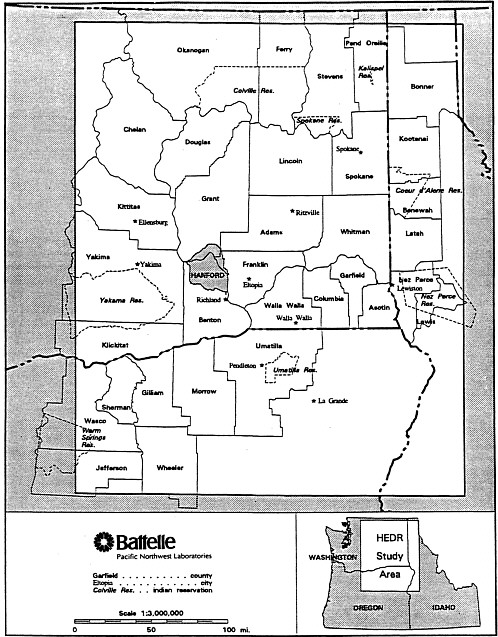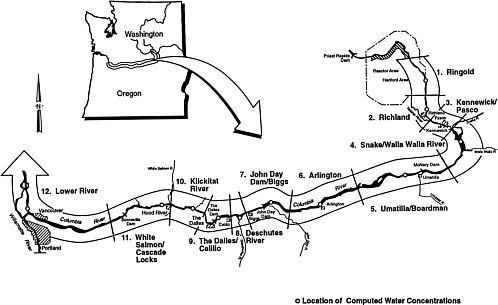I. INTRODUCTION
A. THE COMMITTEE’S FORMATION
Since the 1940s, the Atomic Energy Commission and its successor organizations (now the Department of Energy, DOE) have operated facilities to produce materials for nuclear weapons. In recent years, persons living around those facilities have become increasingly concerned that radioactive releases from the facilities have affected their health. Under a memorandum of understanding concluded with DOE in December 1990, the Department of Health and Human Services, through its Centers for Disease Control and Prevention (CDC), has begun a series of studies to assess the possible health consequences of exposure to releases of radioactive materials from DOE-managed nuclear facilities throughout the United States.
At CDC’s request, the National Research Council has organized the Committee on an Assessment of CDC Radiation Studies in the Board on Radiation Effects Research of the Commission on Life Sciences to provide scientific advice to CDC’s Center for Environmental Health and Injury Control and to evaluate the quality and completeness of CDC’s assessments. The committee’s charge is as follows:
-
Review and comment on the design, methods, analysis, statistical reliability, and scientific interpretation of dose-reconstruction studies and related epidemiologic follow-up studies.
-
Recommend ways to strengthen study protocols and analyses so that the scientific validity of the study results can be ensured.
The Research Council committee visited the Hanford nuclear site in October 1992 to tour the facility. During the visit, the committee received an extensive briefing by members of the Hanford Environmental Dose Reconstruction (HEDR) project:
administrative officials of the contractor, Battelle, Pacific Northwest Laboratories (PNL); and members of the independent Technical Steering Panel (TSP). In addition, the committee held a meeting at which the public was invited and presented concerns about the dose-reconstruction activities under way at Hanford and the perceived potential exposure to radiation resulting from operation of the facility for almost 50 years.
In late 1992, the committee received several documents that had been produced as part of HEDR and was asked to review critically four documents prepared by PNL under contract 200-92-0503 (CDC)18620 (BNW) for the TSP and CDC. The committee conducted its review and published its report, The Hanford Environmental Dose Reconstruction Project: A Review of Four Documents (National Research Council, 1994). The present report comprises a review of two HEDR summary reports that cover the Columbia River pathway and the atmospheric-transport model phases of the project.
B. HANFORD SITE HISTORY
After President Roosevelt’s 1941 directive to the Department of War to develop nuclear weapons, the Hanford site in southeast Washington State was selected as part of the national effort known as the Manhattan Engineer District Project. The location of the Hanford site is shown in Figure 1. Construction started at Hanford in 1943, and a nuclear reactor, the B reactor, became operational in September 1944. Two additional reactors for the production of plutonium, the D and F reactors, became operational in 1945. The early reactors were fueled with aluminum-clad uranium, and part of this uranium was converted into plutonium by the reactor neutron flux. Irradiated fuel was removed from the reactors and sent to two bismuth-phosphate separation plants, the T and B plants. The dissolved fuel material—containing uranium, plutonium, and other radionuclides—was chemically treated to extract and purify the plutonium. Purified plutonium was then formed into metallic disks and shipped to other nuclear facilities for use in the production of nuclear weapons.
The plutonium-production process created many nuclides, including a radioactive isotope of iodine, iodine-131, and the long-lived iodine-129. Most of the iodine-131 was
released to the atmosphere during the processing of fuel from the reactors. Carried by the wind, the iodine-131 was distributed to the ground and rivers and entered the food chain. Iodine-131 is sequestered largely in the thyroid gland. This relatively short-lived radioisotope (half-life, 8.04 days) has received considerable attention during dose-reconstruction studies because it was judged to be the largest contributor to the historic radiation dose attributable to the Hanford nuclear facility (Napier 1991)—over 90% of the effective dose equivalent. For a representative child, the absorbed cumulative dose to the thyroid during 1945-1951 could be as high as approximately 2 Gy.
Over the last 2 decades, concerns have increased about the potential impact of the activities at Hanford on the surrounding population. Continuing declassification of historical Hanford documents, including the release of information about episodic releases of iodine-131 (such as the intentional, experimental release called the Green Run), has made the public more concerned about the possibility of health effects in residents of the area surrounding the Hanford site. Documents describing specific releases of radioactive materials were made available to the public in 1986. Also in 1986, the Hanford Health Effects Review Panel, formed to consider the potential health implications of past releases of radioactive materials from the Hanford site, recommended that DOE conduct a dose-reconstruction project.
In 1986, DOE directed a full study of the release of radioactive materials from Hanford and of the radiation dose received by the surrounding population. The scientific work of the HEDR project was contracted to PNL, which is operated by Battelle Memorial Institute, and the project was expected to be completed in 1995. The goal of the HEDR project was to determine how much radioactive material was released, how many people were exposed, and what radiation dose they might have received. The project is now funded by CDC through the memorandum of understanding previously mentioned. The study is being conducted under the direction of the Technical Steering Panel (TSP). The TSP was created in 1988 and was formed in part to provide independent scientific and public oversight and to facilitate public discussion of past nuclear activities at Hanford.
C. THE TWO HEDR DOCUMENTS
The objective of the HEDR project is to estimate the radiation doses that people could have received as a result of radionuclide emissions from the Hanford site since 1944. Two draft documents prepared by HEDR were submitted for review to the committee in June 1994:
-
Columbia River Pathway Dosimetry Report (PNWD-2227 HEDR), by W.T. Farris, B.A. Napier, J.C. Simpson, S.F. Snyder, and D.B. Shipler.
-
Atmospheric Pathway Dosimetry Report, 1944-1992 (PNWD-2228 HEDR), by W.T. Farris, B.A. Napier, T.A. Ikenberry, J.C. Simpson, and D.B. Shipler.
PNWD-2227 HEDR describes the methods used to estimate doses received by representative individuals who ingested water, fish, or waterfowl from the Columbia River or who swam in or boated on the river (See Figure 2). It uses information from several documents (see PNWD-2227 HEDR, Table S-1, pages ix-x), including information on radionuclides released from Hanford reactors (Heeb and Bates, 1994), on transport of radionuclides in Columbia River water (Walters et al., 1994), on accumulation of radioactivity in aquatic organisms (Thiede et al., 1994), and on dose-calculation methods and human-exposure parameters (Snyder et al., 1994).
It is an update of an earlier report (Pacific Northwest Laboratory, 1991a) but is more complete and includes additional data collected by the HEDR project since 1991. The report includes a 10-page summary with a bar graph of the dose history for a maximum representative individual at Richland, Washington, for each year in 1944-1992. It also includes eight conclusions pertaining to the dose calculations, a table of the key sources of information on the Columbia River pathway, and a glossary. The report contains 78 other pages of text, six pages of references, and a 28-page appendix with lists of estimates of dose equivalents for red bone marrow and lower large intestine and of effective dose equivalents for each of 253 months and annual totals for the period 1950-1971.
PNWD-2228 HEDR focuses on estimating doses received by the thyroid of people who were exposed, directly or indirectly, to radioactive iodine-131 released into the air. A principal exposure pathway for many of these people was milk from cows that ate vegetation contaminated by iodine-131 released into the air from the Hanford Site. This document was produced by staff of HEDR’s Environmental Pathways and Dose Estimates Task Group. It describes the methods used to estimate doses received by representative individuals who consumed contaminated foodstuffs, inhaled contaminated air, or were directly exposed to radioactive materials released from the Hanford site, and it presents re-estimates of many of the doses that were given in an earlier report of a feasibility study for the atmospheric pathway (Pacific Northwest Laboratory, 1991b). The use of new, more-detailed calculation methods resulted in estimated doses that are in some instances half or less than half those presented earlier (see PNWD-2228 HEDR, page ix); for example, the current highest estimate of the median dose received by the thyroid of an infant near Eltopia in 1945 was 1.43 Gy, compared with 3.74 Gy in the feasibility study. The report includes a table of the key sources of information on the atmospheric-pathway analysis (Table P.1) and a 10-page summary. The summary contains six conclusions and two bar graphs; one, an estimate of the effective dose equivalent received by an adult maximum representative individual from key radionuclides at the highest-impact off-site location in 1945-1972 (Figure S.1), and a second, an estimate of the thyroid dose received by an adult maximum representative individual from iodine-131 at the highest- impact off-site location in the same period (Figure S.2). The report also has a glossary. The remainder of the report contains 81 pages of text, 8 pages of references, and four appendixes with a total of 59 pages, including graphs of thyroid dose received by “representative” people at some selected locations.









